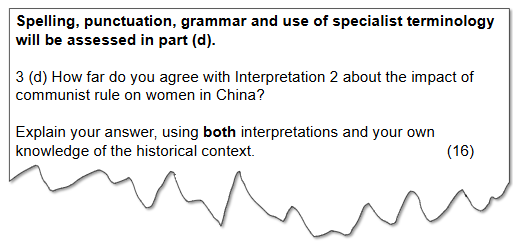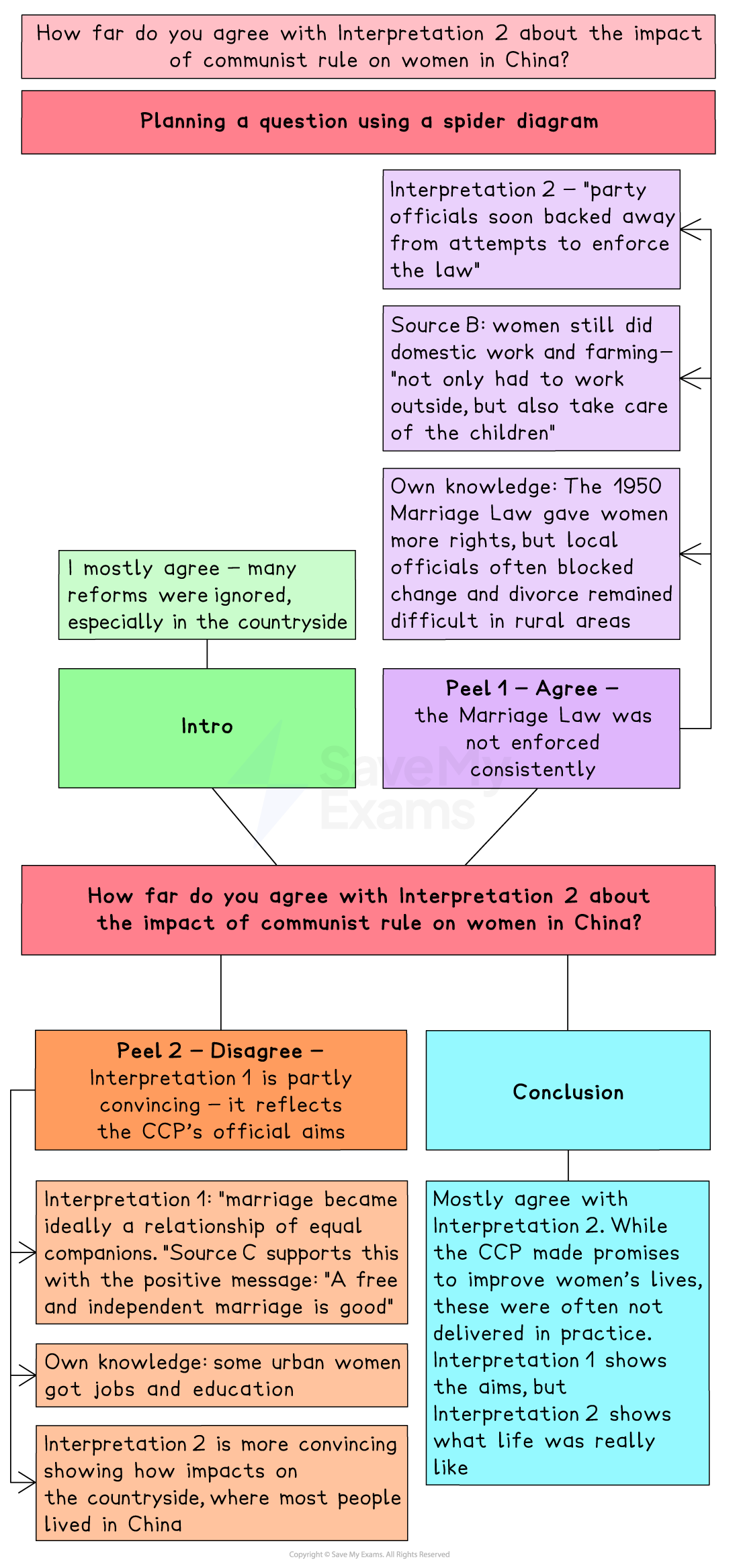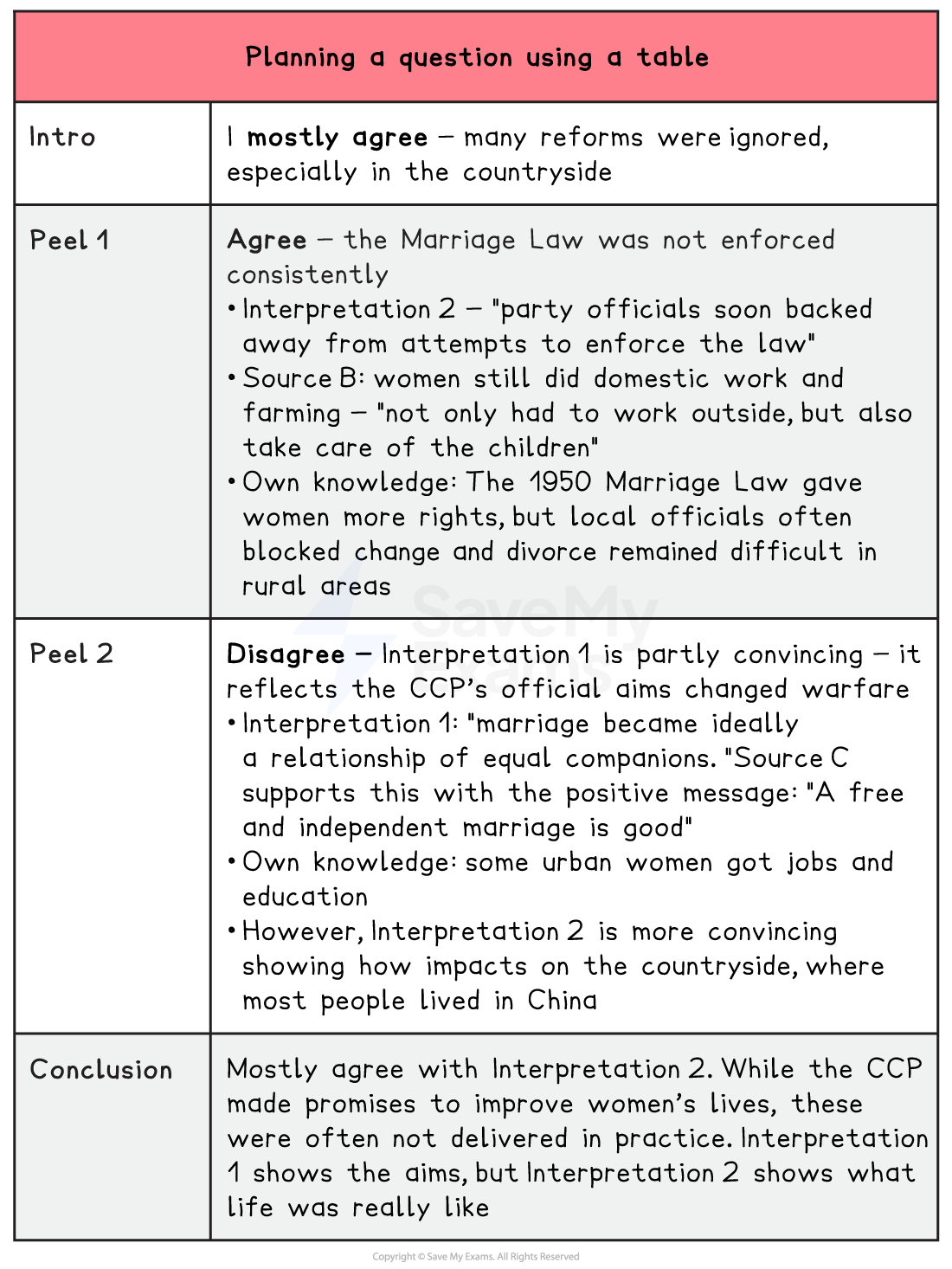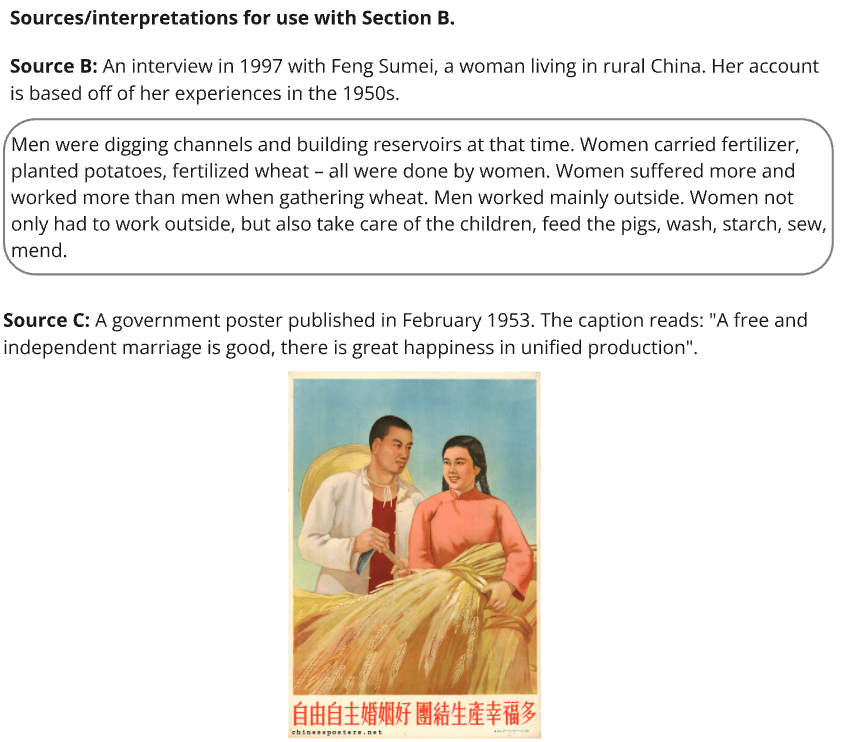The 16 Mark "How Far Do You Agree with Interpretation 2" Question (Edexcel GCSE History): Revision Note
Exam code: 1HI0
Summary of Question 3 (d)
Question 3 (d) requires you to:
Evaluate the topic outlined in the question
Use both Interpretation 1 and Interpretation 2
This will help you to have a balanced argument
Come to an overall judgement on how far you agree with the topic outlined in the question
You should use Sources B and C in your answer
They count as your own knowledge
The interpretations used in Questions 3 (b) and 3 (c) will be the same ones used in this question
Like the 16 mark question in Paper 1, you are awarded marks for Spelling, Punctuation and Grammar (SPaG)
Amount of marks | 16 marks + 4 SPaG marks |
|---|---|
The time that you should spend on the question | 5 minutes of planning 20 minutes of writing |
An example of the type of question you may encounter can be seen below:

In previous years, this question has focused on the following topics in Mao's China:
Year of Exam
Question Topic
2018
Reasons for the success of the CCP in the Civil War (opens in a new tab)
2019
The effects of the Cultural Revolution (opens in a new tab)
2020
Achievements of the First Five-Year Plan (opens in a new tab)
2021
No paper available
2022
Causes of the Great Famine (1958–62) (opens in a new tab)
2023
Reasons for the Cultural Revolution (opens in a new tab)
2024
Healthcare reforms in Mao’s China
Making judgements in history
The 16 mark question relies on your ability to weigh all the evidence from the interpretations and sources, and to state your opinion
Students often find this part the hardest to do
Common mistakes in judgement questions
Explaining that all of the reasons are the most important
Avoiding a clear decision by using phrases like “kind of” or “maybe”
Giving no opinion
Changing your argument halfway through
In the example question, you state in the introduction that you fully agree with Interpretation 2
However, in the conclusion you state that you partially agree with Interpretation 2
Doing this means that there is not a sustained judgement and you can not access Level 4 (13–16 marks)
What makes a good judgement?
Explain how convincing you find Interpretation 2
Consider the other interpretation
Even if you fully agree with Interpretation 2, you must also evaluate Interpretation 1
Have a consistent judgement from start to finish
Use your best evidence to back up your decision
There is no "right" or "wrong" answer in history
What makes a great conclusion in GCSE History?
Conclusions are usually where most of your judgement marks will be awarded
All great conclusions have these three elements:
Judgement — State how far you agree with Interpretation 2
Counter — Introduce an argument against your judgement
Support — Use your strongest evidence to explain why you have reached your judgement on Interpretation 2
How to get SPaG marks
In Paper 3, students have access to an additional four marks for answering Question 3 (d)
This is awarded for SPaG (Spelling, Punctuation and Grammar)
SPaG Mark | Reason for This Mark |
|---|---|
0 |
|
1 |
|
2-3 |
|
4 |
|
Top tips for boosting SPaG marks
Spell historical terms correctly
Use paragraphs
Re-read your work for punctuation
Reading the answer in your head
Where you would take a breath, make sure there is a comma or full stop
How to answer a "How far do you agree with Interpretation 2?" question
This question asks you how far you agree with Interpretation 2 on a specific topic
It will be the same topic and interpretations you used in 3(b) and 3(c)
In the example question, this topic is "the impact of Communist rule on women in China"
To answer this question successfully you should:
Read the answer carefully and multiple times (if you have the time)
Annotate:
The question to know the topic
The interpretations, to come to a judgement
The sources, to select what information you can use to help support your judgement
Plan your answer, including:
What parts of the interpretations and sources you wish to use
An outline of your opinion about Interpretation 2


"How far do you agree with Interpretation 2?" question structure
Your answer should include:
A logical structure
Both Interpretation 1 and Interpretation 2
The use of Source B and Source C
Do not use Source A as you will not be rewarded any marks for your comments
An explanation based on the demands of the question
A clear and sustained judgement throughout the answer
A conclusion
If you want to include an introduction you can, but it is not necessary
Your answers could be written in PEEL paragraphs:
P — Make a point about the question
This should include your judgement on Interpretation 2
E — Use evidence that supports the point that you have made
Evidence can come from Source B and Source C, or your own knowledge
E — Explain why this evidence supports your point
Your explanation should focus on how much you agree with Interpretation 2
L — Link your explanation back to the question to help sustain your argument and show your understanding of the question
The question is out of 20 marks:
16 marks are awarded for analysis and evaluation of the interpretations (In)
4 marks are awarded for Spelling, Punctuation and Grammar (SPaG)
This is an overall mark, not awarded in specific areas of your answer
Worked example of a "How far do you agree with Interpretation 2?" question
Worked Example
3 (d) How far do you agree with Interpretation 2 about the impact of Communist rule on women in China?
Explain your answer, using both interpretations and your own knowledge of the historical context.
(16)
![Interpretation 1 – From Defining Difference: The "Scientific" Construction of Sexuality and Gender in the People's Republic of China, H. Evans, published in 1995.
"Marriage became ideally a relationship of equal companions who shared responsibility for child care and the family ... Between 1950 and 1953, numerous publications sought to educate the public about the new [marriage] law, with particular emphasis on its importance for women, oppressed for centuries by the traditional system of arranged marriage."
Interpretation 2 – From State of the Field: Women in China's Long Twentieth Century, G. Hershatter, published in 2004.
"Aside from a one-month period of intensified publicity for the Marriage Law in March 1953, party officials soon backed away from attempts to enforce the law, particularly when it engendered conflicts with the priorities of land reform and collectivisation. Divorce spiked briefly in 1953 with the campaign to publicize the Marriage Law [and] remained low throughout the rest of the Mao era."](https://cdn.savemyexams.com/cdn-cgi/image/f=auto,width=3840/https://cdn.savemyexams.com/uploads/2025/08/10672_httpscdn-savemyexams-comuploads20250836973-httpscdn-savemyexams-comuploads20250860540-httpscdn-savemyexams-comuploads20250836545-httpscdn-savemyexams-comuploads20250858197-httpscdn-savemyexams-comuploads20250727939-interpretations-china.png)

Answer:
I mostly agree with Interpretation 2 that the impact of Communist rule on women was either small or negative due to other policies taking priority (In).
Interpretation 2 states that policies such as the Marriage Law were not enforced if they got in the way of "the priorities of land reform and collectivisation". This is supported by Source B, in which a rural woman describes how women "not only had to work outside but also take care of the children, feed the pigs, wash, starch, sew, mend". This shows that although Communist policies claimed to support gender equality, in reality, many rural women continued to experience traditional burdens and double workloads (In). From my own knowledge, the 1950 Marriage Law was a major policy that outlawed arranged marriages and gave women the right to divorce. However, in practice, particularly in the countryside, many local officials did not support these reforms, and women often faced pressure not to divorce or challenge family traditions. Therefore, this evidence supports Interpretation 2’s argument that Communist policies for women were often ignored when they conflicted with other aims (In).
Interpretation 1 gives a more positive view, arguing that "marriage became ideally a relationship of equal companions who shared responsibility for child care and the family" (In). This is supported by Source C, which shows a happy couple and the caption: "A free and independent marriage is good." From my own knowledge, there was a major government campaign between 1950 and 1953 to promote the Marriage Law and gender equality. In cities, some women did benefit from better access to education and employment opportunities. For example, many women became teachers or worked in factories as part of the state’s industrial growth. However, while these gains were significant, they mostly benefitted urban women and were not always sustained, especially during the Cultural Revolution when schools collapsed and women’s work was devalued. Therefore, this supports the Interpretation 2 viewpoint that women experienced little progress under the CCP (In).
Overall, I mostly agree with Interpretation 2 about the impact of Communist rule on women. Although Communist rule introduced important reforms for women, these were often not enforced, especially in rural areas where traditional roles continued (In). Interpretation 1 is partly convincing because it shows what the government intended, but Interpretation 2 is more accurate in showing what actually happened. Women’s rights were often put aside when they clashed with the priorities of the state, such as economic development under the Great Leap Forward (In).

Unlock more, it's free!
Did this page help you?